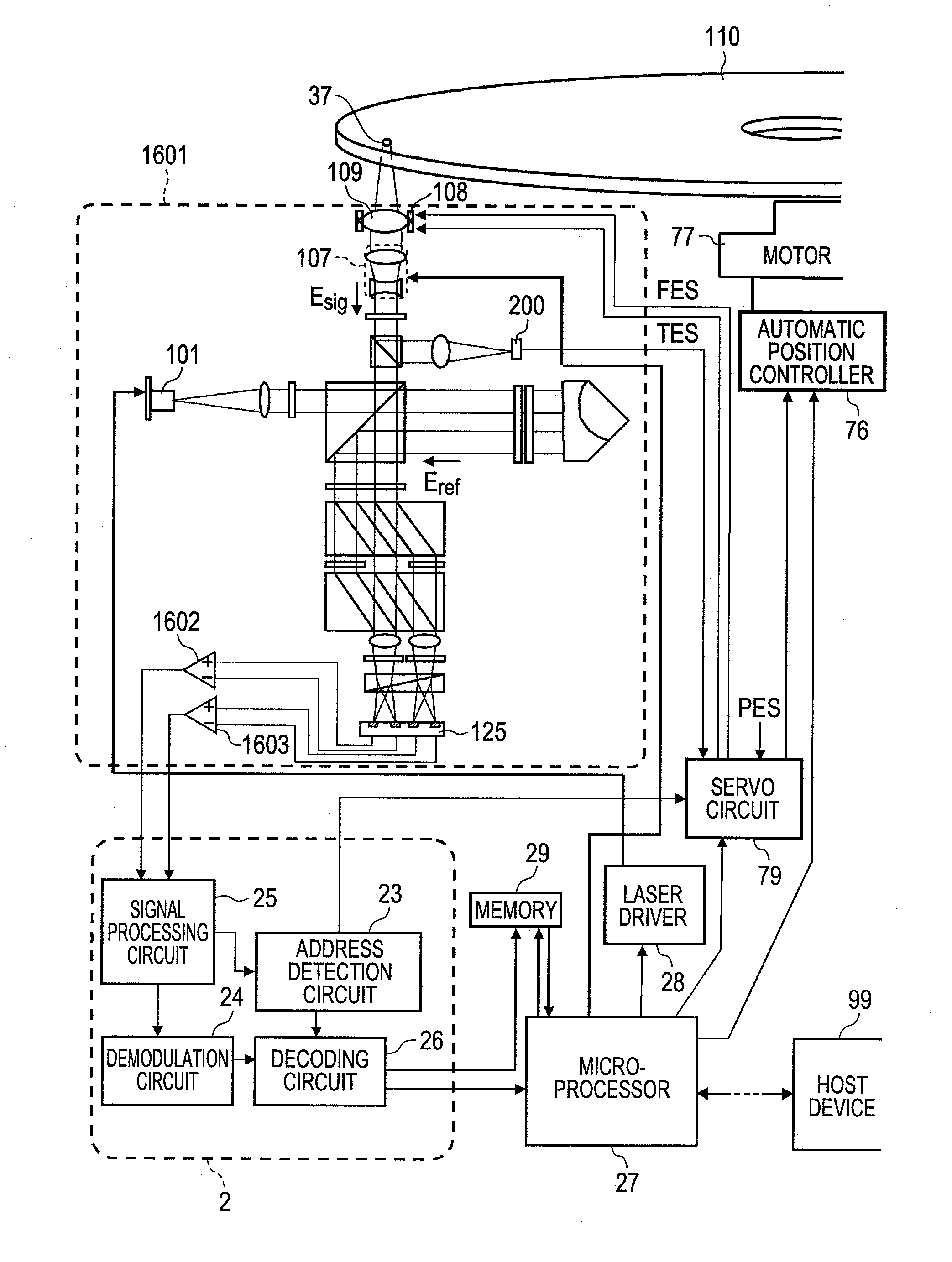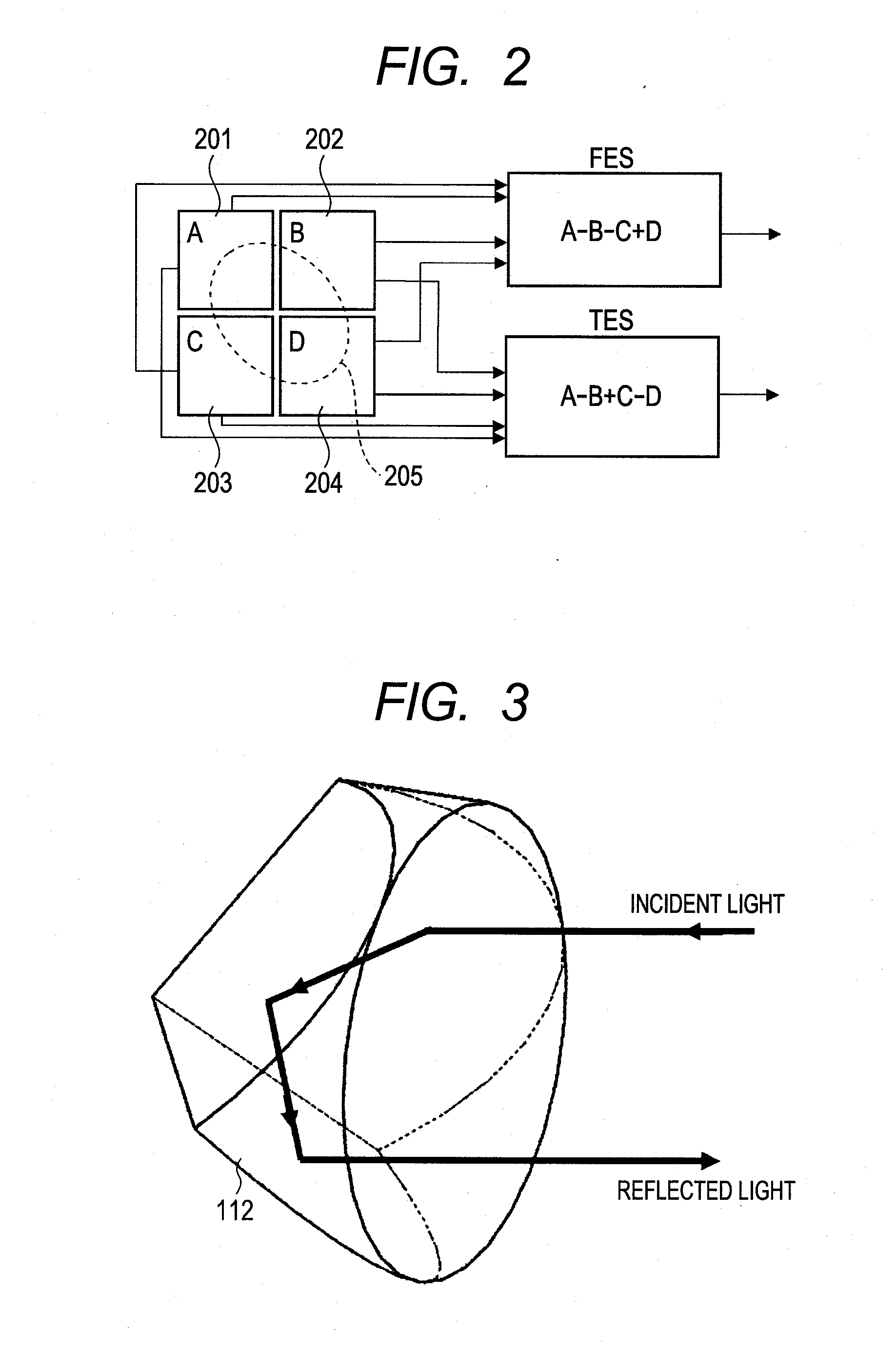Optical head and optical disc apparatus
a technology of optical discs and optical head, which is applied in the field of optical head and optical disc apparatus, can solve the problems of destabilizing regeneration signals, difficult to control the values of such phase differences to a desired value, and optical axis shift, and achieves stable output, high signal amplification effect, and easy adjustment of two beam axes
- Summary
- Abstract
- Description
- Claims
- Application Information
AI Technical Summary
Benefits of technology
Problems solved by technology
Method used
Image
Examples
first embodiment
[0053]Now, a first embodiment of the present invention will be described with reference to FIG. 1.
[0054]FIG. 1 shows a basic configuration of an optical head according to this embodiment. Light from a semiconductor laser 101 is converted by a collimate lens 102 into parallel beams, which then pass through a half-wave plate 103 and come into a polarization beam splitter 104. The polarization beam splitter 104 has functions of transmitting approximately 100% of p-polarization (hereafter referred to as “horizontal polarization”) incident on its split surface and reflecting approximately 100% of s-polarization (hereafter referred to as “vertical polarization”) incident thereon. The intensity ratio between transmitted light and reflected light can be adjusted by adjusting the rotation angle of the half-wave plate around the optical axis. The reflected light (hereafter referred to as “signal light”) initially comes into a specialized polarization beam splitter 105. As its characteristics,...
second embodiment
[0068]This embodiment is an embodiment where the signal light and the reference light are multiplexed and then split again. FIG. 10 shows a configuration diagram of this embodiment. As in the first embodiment, the signal light is reflected by the optical disc 110, travels back along the optical path, and passes through the polarization beam splitter 104. On the other hand, the reference light passes through a quarter-wave plate (axis direction: 45° relative to the horizontal polarization direction) 1001, is condensed on a mirror 1003 by a lens 1002, reflected by the 1003, travels along the optical path in a 180° opposite direction, and passes through the quarter-wave plate 1001 again. Thus, the polarization is rotated by 90°. When the reference light is reflected by the polarization beam splitter 104, the signal light and the polarization are multiplexed in a perpendicular state. The multiplexed beam is condensed by a lens 1004 and split by a beam displacer 1005 so that the split be...
third embodiment
[0071]This embodiment is an embodiment where the process of splitting each of the signal light and reference light to cause the signal light and reference light to interfere with each other in different phases and the process of multiplexing the split signal light and reference light are performed simultaneously. FIG. 12 shows a configuration diagram of this embodiment. This embodiment is the same as the first embodiment until the signal light and the reference light pass through a half-wave plate (axis direction: 22.5° relative the horizontal polarization direction) 115. The signal light and the reference light are multiplexed by a polarization beam splitter 1201, and two multiplexed beams go out thereof. The polarization states of the signal light and the reference light at that time are as shown in FIG. 13. The horizontal polarization components of the signal light pass through the polarization beam splitter 1201, as well as are multiplexed with the vertical polarization componen...
PUM
| Property | Measurement | Unit |
|---|---|---|
| wavelength | aaaaa | aaaaa |
| reflectance | aaaaa | aaaaa |
| speed | aaaaa | aaaaa |
Abstract
Description
Claims
Application Information
 Login to View More
Login to View More - R&D
- Intellectual Property
- Life Sciences
- Materials
- Tech Scout
- Unparalleled Data Quality
- Higher Quality Content
- 60% Fewer Hallucinations
Browse by: Latest US Patents, China's latest patents, Technical Efficacy Thesaurus, Application Domain, Technology Topic, Popular Technical Reports.
© 2025 PatSnap. All rights reserved.Legal|Privacy policy|Modern Slavery Act Transparency Statement|Sitemap|About US| Contact US: help@patsnap.com



